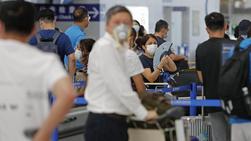 Passengers at Pudong International Airport in Shanghai, on Aug 10, 2020. (PHOTO / VCG)
Passengers at Pudong International Airport in Shanghai, on Aug 10, 2020. (PHOTO / VCG)
Transfers at airports overseas may pose a higher risk of contracting COVID-19 as the pandemic continues to evolve and rebound in some parts of the world, experts said.
Compared with a direct flight returning to China, hourslong stopovers at an international airport expose passengers to higher risks of coming into contact with public facilities and people from different countries. Moreover, some international airports do not demand that all passengers have a negative nucleic acid test result for COVID-19, experts said.
Experts warned that after touching trays at security checkpoints, ATMs, vending machines, escalator handrails and seat armrests in terminal waiting areas, passengers should wash their hands. They were also urged to wear masks throughout their entire journeys, including in terminals and on shuttle buses during transfers
"Nations are different in their strength and effectiveness in preventing and controlling the virus' spread, which means at some airports, which can be densely packed, people may stand a higher chance of being infected by the virus," said Wang Yanan, editor-in-chief of Aerospace Knowledge magazine.
ALSO READ: Mainland reports no new local virus cases, 21 imported
Gao Fu, director of the Chinese Center for Disease Control and Prevention, said previously that flight transfers would increase the chance of infection, mainly owing to close contact with other passengers from different flights and countries, including some patients potentially in the incubation period of the disease.
Statistics from the Shanghai municipal government showed that nearly half of the 102 imported cases of COVID-19 reported in the city last month involved an international flight transfer.
A research paper published in the social sciences journal Risk Analysis showed that public hygiene measures at the world's 10 largest airports, including frequent hand washing and disinfection of public facilities, could reduce the transmission rate of a respiratory pandemic by 37 percent. It said that if such measures were applied to all airports, the rate could decrease by nearly 70 percent.
Experts warned that after touching trays at security checkpoints, ATMs, vending machines, escalator handrails and seat armrests in terminal waiting areas, passengers should wash their hands. They were also urged to wear masks throughout their entire journeys, including in terminals and on shuttle buses during transfers.
READ MORE: Govt announces new entry rules for foreigners
Addressing the risk of a respiratory disease virus spreading inside an airplane cabin, the Civil Aviation Administration said the air inside a cabin is refreshed every two to three minutes-even more frequently than in a hospital operating theater or delivery room-and the up-to-down air circulation model in the cabin can reduce the possibility of the virus spreading.
The International Civil Aviation Organization said of the severe acute respiratory syndrome virus in 2003 that only those in the two rows in front of and behind a virus carrier in a flight cabin might be infected-but that was only the case when nobody was walking around.
In August, the Chinese embassy in the United Kingdom suggested Chinese citizens take direct flights to return to the country. The Ministry of Foreign Affairs has also reminded citizens to be cautious in choosing to transfer flights in countries including Russia, Australia, Japan, Mexico, Ethiopia and Cambodia.


